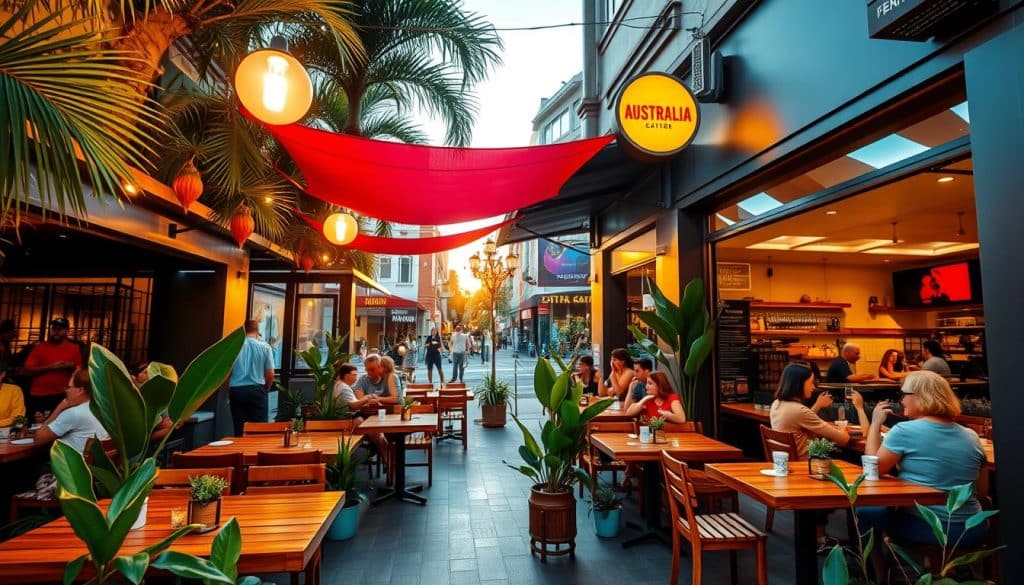Opening a restaurant in Australia is a thrilling chance for those who love cooking and want to run their own place. The Australian restaurant scene is lively and full of possibilities. But, getting into this competitive market needs careful planning and a good strategy.
This guide will share key tips for starting a restaurant in Australia. You’ll learn about local rules and how to market your business well. We aim to give you the knowledge to succeed in the fast-paced Australian restaurant world.
The Australian Restaurant Landscape

Australia’s restaurants are a mix of many cultures. This mix has changed how people eat in recent years. Now, people want real food, using local ingredients and dishes from around the world.
Today’s restaurant trends are all about unique experiences. Gone are the days of just eating traditional meals. Restaurants are now focusing on special menus, like vegan options or dishes that mix different flavours.
- Food delivery apps have changed how we eat out. Restaurants must now offer more than just sit-down meals.
- More people care about what they eat. So, restaurants are making healthier food choices.
- Places like pop-up restaurants and themed cafes are becoming popular. They offer new and exciting dining experiences.
To succeed, it’s key to understand Australian food culture. Restaurant owners need to keep up with new trends. This way, they can meet their customers’ changing tastes.
Understanding Local Regulations

Starting a restaurant in Australia means you must understand the rules. Each place has its own licensing requirements. Knowing these is key to running a successful business.
You’ll need permits like a food service licence and a liquor licence. These are crucial for legal operation and community approval. Following health and safety laws is also vital for a safe place to eat.
Business owners must also follow Fair Work Australia rules. These cover employee rights and work conditions. Staying compliant helps avoid legal trouble and creates a good work atmosphere.
Local government websites are a great resource for all the necessary documents. Getting advice from a legal expert in the hospitality field can also help avoid problems.
Choosing the Right Location

Finding the perfect spot for a restaurant is key to success. The right location strategy should look at footfall and visibility. This includes being close to transport and local attractions.
When choosing a site, consider these factors:
- Foot traffic: Busy areas mean more customers.
- Visibility: Easy to spot from roads or paths boosts awareness.
- Competitors: Knowing who else is around helps avoid too much competition.
- Target demographic: Understanding the local community helps tailor your offer.
Doing a deep dive into the local demographics is crucial. It helps you know what people like to spend on and what they prefer. This is vital for your menu and prices. Also, picking areas with growing populations and little competition can really help your business.
Working with real estate agents who know commercial properties is a good idea. They can help find the best spot for you. Their knowledge can make the site selection easier and help your restaurant thrive in the long run.
Tips for Opening a Restaurant in Australia

Starting a restaurant needs careful planning and action. Using good restaurant business tips is key to a strong start and success. Setting clear goals gives direction, and knowing your target market helps tailor your offerings to meet customer needs.
Setting Clear Objectives
Clear objectives are the core of a successful restaurant plan. Financial goals include revenue, profit margins, and cost control. Customer satisfaction goals help improve guest experiences and build loyalty. Having clear, measurable goals keeps everyone focused and motivated.
Identifying Your Target Market
Understanding your target market is crucial for a great dining experience. Knowing your customers’ demographics helps design menus and promotions. Market research through surveys, focus groups, and competitor analysis offers insights to improve your offerings and marketing.
Creating a Unique Concept

Developing a restaurant concept is key to success. A unique idea sets your place apart in a crowded market. It draws in and keeps customers coming back. Ideas can come from many places, like special themes, local foods, or new service styles.
Think about these points when creating your concept:
- Do deep research to know what customers like and what’s trending.
- Look at successful, innovative restaurants for ideas.
- Use your own love for food to make experiences real and true.
- Think about being green by using local ingredients, appealing to those who care about the planet.
Creating memorable dining experiences is vital. Things like cooking with guests or unique decor can make a big difference. Keeping your menu fresh and exciting is also important. It should be new but still something customers will enjoy.
Developing a Comprehensive Business Plan

A detailed restaurant business plan is key to starting and keeping a business going. It outlines the restaurant’s goals, who it aims to serve, and who its competitors are. It also includes a marketing strategy and an operational plan to keep the business on track.
Financial Projections and Costs
Forecasting finances is vital in the business plan. It shows expected income and expenses over time. The financial part should list initial costs and ongoing expenses. This includes:
- Renovation and decor expenses
- Purchasing equipment
- Obtaining necessary permits
- Staff salaries and training costs
- Utilities and regular supply purchases
- Marketing and promotional activities
Understanding these costs helps in making accurate financial predictions. It sets a strong base for managing money and facing unexpected issues. This analysis helps investors or lenders see the financial commitment needed and if the business is viable.
Securing Funding and Capital
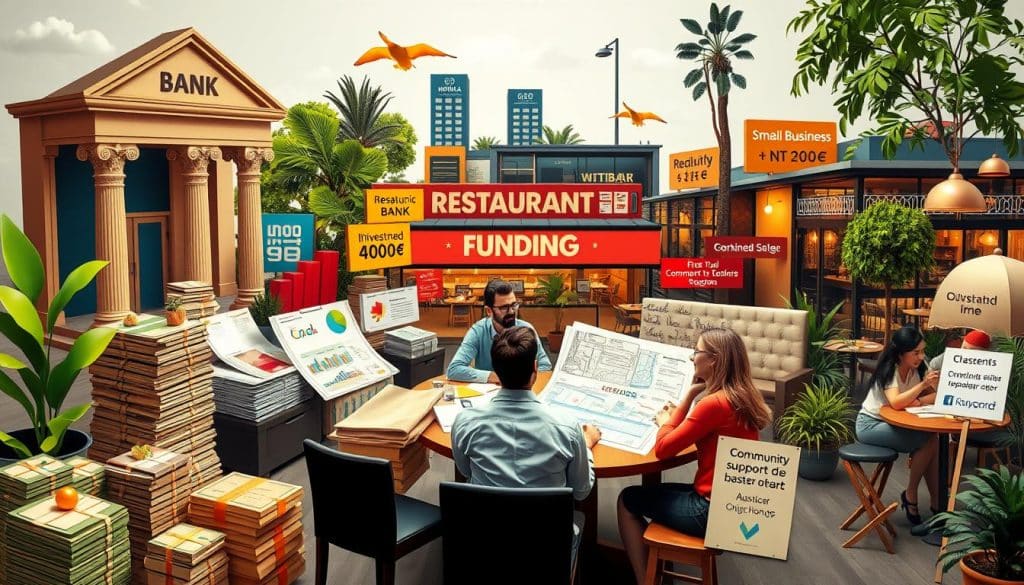
Getting enough money is key to making a restaurant dream come true. Looking at different restaurant funding options helps find the right match for your budget. You might consider:
- Bank loans, which give a lot of money but have tough repayment terms and high interest.
- Investors, who can put in a lot of capital but might want to control your business.
- Crowdfunding sites, where people can chip in together, maybe for rewards or a share of your business.
- Using your own savings, which means no debt but could risk your personal money.
Every option has its good and bad sides. When you’re financing a restaurant, think about things like interest rates, how often you’ll pay back, and who will own the business. A solid business plan is crucial. It shows you know your stuff and have a clear plan for making money.
Designing an Inviting Ambience
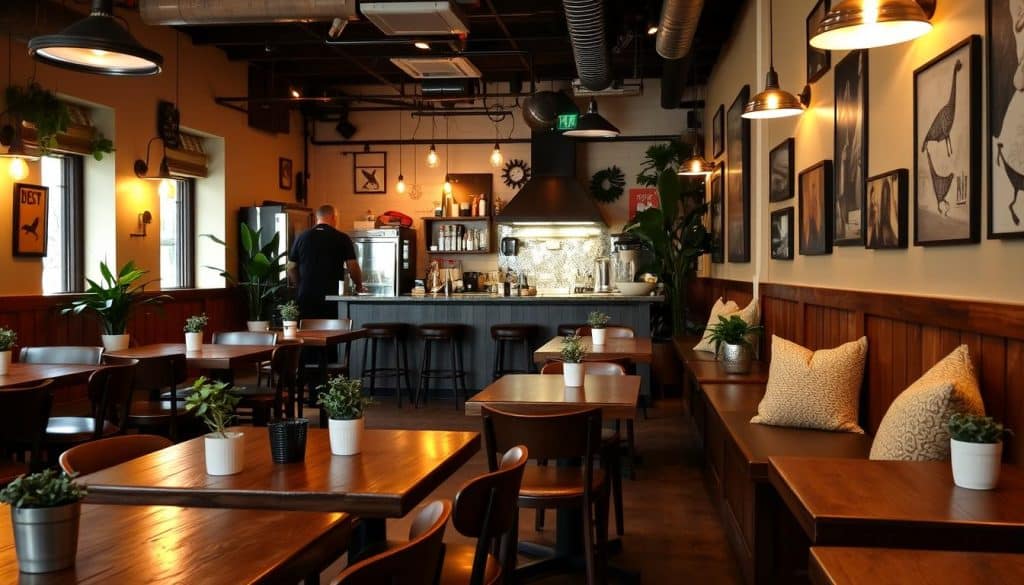
The ambience of a restaurant is key to a great customer experience. A welcoming dining atmosphere can make a big difference. It can boost customer happiness and keep them coming back. To get this right, several parts of the restaurant’s design need attention.
- Interior Design: Choosing a theme that fits your brand creates a unified look.
- Lighting: Good lighting sets the mood, making features stand out while keeping things comfy.
- Acoustics: Managing sound well can make dining better, allowing for easy chats without too much noise.
- Seating Arrangements: Well-placed tables and chairs help people chat while still having their own space.
- Flow and Efficiency: A well-designed layout makes service smooth, letting staff move easily between the kitchen and dining area.
Working with a skilled interior designer is very helpful. They can turn your ideas into reality. Their knowledge in hospitality helps make the space welcoming and true to your restaurant’s spirit.
Menu Creation and Pricing Strategies
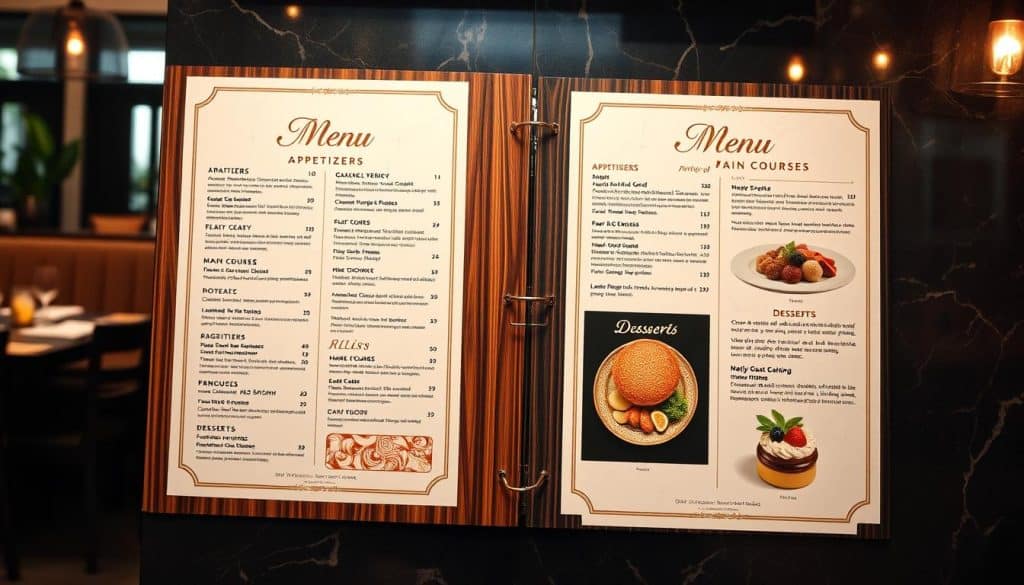
Creating a good restaurant menu is crucial. Using local ingredients makes your food more appealing and builds community ties. It also lets customers taste their local flavours. Seasonal dishes are key, using fresh produce at the right times.
Incorporating Local Flavours
Using local flavours needs careful planning. Working with nearby farms and suppliers gets you top-quality ingredients. This supports local businesses and meets consumer demands for sustainable food.
Here are ways to make your menu more local:
- Collaborate with local chefs to create signature dishes.
- Highlight farm-to-table options on the menu.
- Host seasonal events focusing on regional cuisines.
Seasonal Menu Adjustments
Changing your menu with the seasons keeps things fresh. Seasonal ingredients add flavour and freshness. Pricing should reflect this, offering good value to customers.
Here are tips for seasonal menu changes:
- Regularly review and adapt offerings based on ingredient availability.
- Utilise customer feedback during seasonal transitions to refine dish selection.
- Leverage social media to promote seasonal specials and engage with customers.
Building a Strong Brand Identity

A strong brand identity is key for any restaurant wanting to stand out. It’s not just a name; it’s everything that makes the place look and feel special. A unique logo is the start, and matching visuals create a look that customers love.
What makes a brand stand out includes:
- A memorable logo that shows what the restaurant is all about
- Consistent colours and fonts everywhere
- A story that speaks to the people it wants to reach
- A lively social media that shows the restaurant’s true self
Being consistent is vital for brand recognition. Signs, menus, and online profiles should all look the same. This makes diners feel at home and builds trust, leading to loyalty.
Also, having a unique voice and personality for the restaurant draws people in. This voice should speak to the audience it aims for, making marketing more personal and successful. A clear brand identity attracts new customers and keeps them coming back.
Marketing Strategies for Your Restaurant
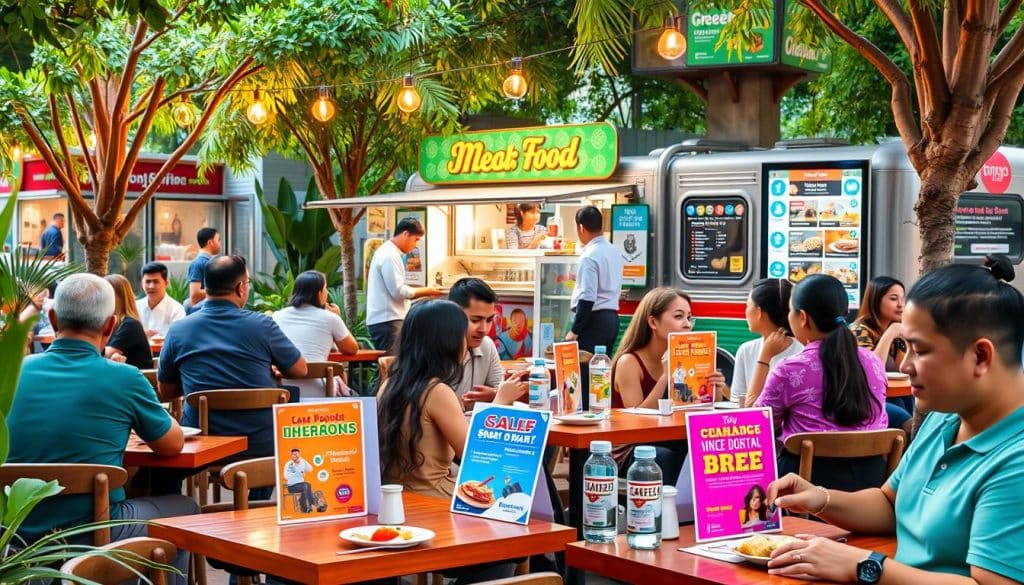
Effective restaurant marketing is key to drawing in new customers and keeping the ones you have. Using different channels helps you reach more people and build your brand. Mix digital marketing, like social media, with old-school tactics like flyers and local deals.
Social media is a great way to get people talking about your restaurant. Share interesting stuff and show off what makes you special. This way, you can build a community around your brand.
Offering deals and loyalty programmes can make people come back for more. Hosting special events or giving discounts can bring in new faces. It also makes people more likely to tell their friends, which is free marketing.
Hiring and Training Staff Effectively
Building a successful restaurant starts with effective staffing. First, create a clear recruitment process. This defines roles and responsibilities, attracting the right candidates. It improves service quality and creates a positive work environment.
Employee training is key to maintaining high standards. Training should cover customer service, menu knowledge, and health and safety. This makes your staff confident and improves customer experience.
To keep staff loyal, offer ongoing development. Regular training, feedback, and team activities build a strong team. This boosts morale and improves your restaurant’s reputation.

